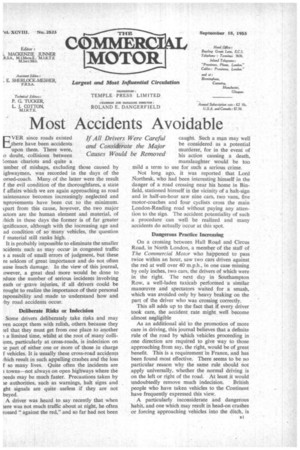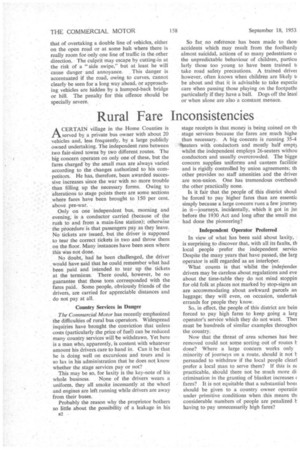Most Accidents Avoidable
Page 35

Page 36

If you've noticed an error in this article please click here to report it so we can fix it.
EVER since roads existed there have been accidents upon them. There were, o doubt, collisions between Lornan chariots and quite a umber of mishaps, excluding those caused by ighwaymen, was recorded in the days of the orsed-coach. Many of the latter were the result I the evil condition of the thoroughfares, a state I affairs which we are again approaching as road iaintenance becomes increasingly neglected and nprovements have been cut to the minimum. wart from this cause, however, the two major ictors are the human element and material, of /Inch in these days the former is of far greater ignificance, although with the increasing age and ad condition of so• many vehicles, the question f material still ranks high.
It is probably impossible to eliminate the smaller ricidents such as may occur in congested traffic s a result of small errors of judgment, but these re seldom of great importance and do not often ause Much damage. In the view of this journal, .owever, a great deal more would be done to educe the number of serious incidents involving eath or grave injuries, if all drivers could be rought to realize the importance of their personal Dsponsibility and made to understand how and rhy road accidents occur.
Deliberate Risks or Indecision Some drivers deliberately take risks •and may yen accept them with relish, others because they eel that they must get from one place to another 1 a limited time, whilst at the root of many colliions, particularly at cross-roads, is indecision on le part of either one or more of those in charge f vehicles. It is usually these cross-road accidents Thich result in such appalling crashes and the loss f so many lives. Quite often the incidents are i towns not always on open highways where the Deeds may be much faster. Precautions taken by le authorities, such as warnings, halt signs and ght signals are quite useless if they are not beyed.
A driver was heard to say recently that when tere was not much traffic about at night, be often rossed " against the red," and so far had not been caught. Such a man may well be considered as a potential murderer, for in the event of his action causing a death, manslaughter would be too mild a term to use for such a serious crime.
Not long ago, it was reported that Lord Northesk, who had been interesting himself in the danger of a road crossing near his home in Binfield, stationed himself in the vicinity of a halt-sign and in half-an-hour saw nine cars, two vans, five motor-coaches and four cyclists cross the main London-Reading road without paying any attention to the sign. The accident potentiality of such a procedure can well be realized and many accidents do actually occur at this spot.
Dangerous Practice Increasing On a crossing between Hall Road and Circus Road, in North London, a member of the staff of The Commercial Motor who happened to pass twice within an hour, saw two cars driven against the red at well over 40 m.p.h., in one case missing by only inches, two cars, the drivers of which were in the right. The next day in Southampton Row, a well-laden taxicab performed a similar manceuvre and spectators waited for a smash, which was avoided only by heavy braking on the part of the driver who was crossing correctly.
This all adds up to the fact that if every driver took care, the accident rate might well become almost negligible As an additional aid to the promotion of more care in driving, this journal believes that a definite rule of the road by which vehicles proceeding in one direction are required to give way to those approaching from say, the right, would be of great benefit This is a requirement in France, and has been found most effective. There seems to be no particular reason why the same rule should not apply universally, whether the normal driving is on the left or right of the road. At least it would undoubtedly remove much indecision. British people who have taken vehicles to the Continent have frequently expressed this view.
A particularly inconsiderate and dangerous habit, and one which may result in bead-on crashes or forcing approaching vehicles into the ditch, is that of overtaking a double line of vehicles, either on the open road or at some halt where there is really room for only one line of traffic in the other direction. The culprit may escape by cutting-in at the risk of a "side swipe," but at least he will cause danger and annoyance. This danger is accentuated if the road, owing to curves, cannot clearly be seen for a long way ahead, or approaching vehicles are hidden by a humped-back bridge or hill. The penalty for this offence should be specially severe. So far, no reference has been made to thost accidents which may result from the foolhardy almost suicidal, actions of so many pedestrians o the unpredictable behaviour of children, particu larly those too young to have been trained t( take road safety precautions. A trained drivel however, often knows when children are likely t■ be about and that it is advisable to take especia care When passing those playing on the footpaths particularly if they have a ball. Dogs off the leas] or when alone are also a constant menace.




































































































